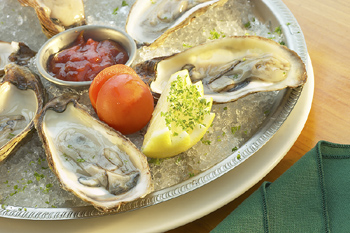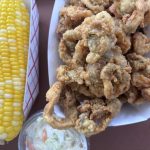Oyster History and Recipes
Whether we are drawn to oysters for their supposed powers as an aphrodisiac or for their salty, creamy sweetness, they are part and parcel to the New England experience and our love for our beautiful, if rugged, coastline. Oysters have been consumed as a foodstuff from prehistoric times, through the Greek and Roman empires, to […]

Coffee By Design | Portland, Maine
Photo Credit : Katherine KeenanWhether we are drawn to oysters for their supposed powers as an aphrodisiac or for their salty, creamy sweetness, they are part and parcel to the New England experience and our love for our beautiful, if rugged, coastline. Oysters have been consumed as a foodstuff from prehistoric times, through the Greek and Roman empires, to the present day, when they appear everywhere from fine-dining establishments to simple roadside beach shacks and raw bars at weddings. The oldest continuously operated restaurant in America, the Union Oyster House in Boston, has been serving them since 1826. We thought it was high time to take a moment and salute one of our favorite ingredients.
Oysters are named for the locations where they are grown and are a point of pride for our many coastal towns. Anyone from Wellfleet, Massachusetts, will tell you that their oysters are far better than those from Damariscotta, Maine. We’d be hard-pressed to find flaws in either. The cold waters of Maine, New Hampshire, Massachusetts, Rhode Island, and Connecticut are perfect growing areas for the Crassostrea virginica, or eastern oyster. Each bay, harbor, and estuary where oysters grow has a different mix of minerals and plankton (on which oysters feed), as well as salt levels, giving the same species of oysters markedly different flavors, textures, and colors despite being raised within miles of each other.
Nature Flips a Switch
Eastern oysters begin life as males; however, depending on the season and the needs of a particular oyster bed, some oysters will become female and produce eggs. There is no way to distinguish male oysters from females by examining their outer shells — and most folks can’t tell by looking at their insides either.
The Food of Love?
It could be the power of suggestion: Once a food is labeled an aphrodisiac, it seems to work. Myth or not, oysters have long been considered a food of love. As far back as the 1700s, the great womanizer Giacomo Casanova is said to have consumed up to four or five dozen oysters a day to keep him “fit” for his many escapades. Oysters are high in protein and full of nutrients. They’re especially high in zinc, which helps to regulate testosterone and progesterone levels. This in turn helps maintain the libido in both men and women.
The Thing About R
Folklore says that oysters should be eaten only in months with an “r” in them, but science has shown that oysters may be eaten safely 12 months a year. Warm-weather months sans the r (May, June, July, and August) are spawning time for most oysters. During that time, oysters are often softer in texture and watery in taste, but they are delicious and readily available.
The Raw and the Cooked
When considering the oyster — despite how delicious they are fried, stuffed, roasted, baked, steamed, Rockefellered, and even raw — we still wonder, who ate the first one? Whoever it was and however it happened, we are glad it did.
View our slide show on Matunuck Oyster Harvest, then follow the link below to more articles and recipes.





This is very interesting to me as my husband, daughter and son-in-law are all working an oyster grant in Wellfleet, MA. We just attended the Oysterfest in Wellfleet last week-end and found that many people indeed love oysters. What most people don’t realize is the amount of work that goes into raising oysters. My family loves farming oysters and am excited to check out all the oyster recipes you have included in your featured article today.
In Southern Maryland, we do NOT harvest or eat oysters mid-April thru mid-October. Oysters are just NOT available during those months. After the traditional Blessing of the (oyster) Fleet on Blackistone Island, oysters become increasingly available and are harvested in the Patuxent, Potomac and Wicomico Rivers. The are large, plump and delicious. They must be fresh or they taste strongly of iodine. Recipe calls for lots of celery and a goodly splash of sherry added to the white suace. My wife’s recipe for oyster stew tops any other recipes we’ve tried. We alternate each week: one week stew, next fried.
SCW